Question 1
Three resistors, each of resistance `R`, are connected in a network, as shown.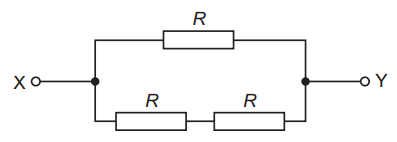 The total resistance between points X and Y is 8.0 Ω. What is the value of `R`?
The total resistance between points X and Y is 8.0 Ω. What is the value of `R`?
Easy
Mark as Complete
Mark Scheme
Question 2
Some resistors and a battery of electromotive force (e.m.f.) E and negligible internal resistance are connected in series, as shown.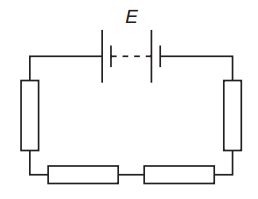 Which statement is correct?
Which statement is correct?
A. The e.m.f. across each resistor equals the potential difference across the battery.
B. The potential difference across each resistor equals the e.m.f. E of the battery.
C. The sum of the e.m.f.s across the resistors equals the potential difference across the battery.
D. The sum of the potential differences across the resistors equals the e.m.f. E of the battery.
Easy
Mark as Complete
Mark Scheme
Question 3
In the circuit shown, a fixed resistor X is connected in series with a battery and a variable resistor.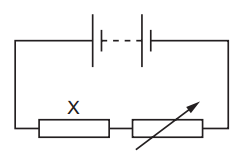
The power dissipated in resistor X is 7.2 W when a current of 3.0 A passes through it.
The variable resistor is adjusted so that the power dissipated in X increases by 50%.
What is the new current in the circuit?
Medium
Mark as Complete
Mark Scheme
Question 4
A circuit contains a cell of electromotive force and internal resistance rr connected to a resistor of resistance . The current in the circuit is I.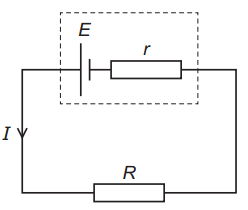 Which equation is correct?
Which equation is correct?
A. E − Ir.
B. E = Ir − IR.
C. E + Ir = IR.
D. E = IR.
Easy
Mark as Complete
Mark Scheme
Question 5
A battery with a constant internal resistance is connected to a resistor of resistance 250 Ω, as shown. The current in the resistor is 40 mA for a time of 60 s. During this time, 6.0 J of energy is dissipated by the internal resistance.
The current in the resistor is 40 mA for a time of 60 s. During this time, 6.0 J of energy is dissipated by the internal resistance.
What is the energy supplied to the external resistor during the 60 s and the electromotive force (e.m.f.) of the battery?
| Energy/J | e.m.f./V | |
|---|---|---|
| A | 30 | 2.5 |
| B | 30 | 7.5 |
| C | 24 | 10.0 |
| D | 24 | 12.5 |
Medium
Mark as Complete
Mark Scheme
Question 6
A voltmeter reads 9.000 V when it is connected across the terminals of a battery.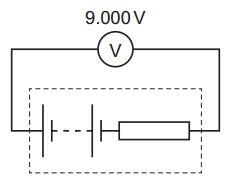 When a resistor of resistance 11.0 Ω is connected in parallel with the battery, the voltmeter reading changes to 8.800 V.
When a resistor of resistance 11.0 Ω is connected in parallel with the battery, the voltmeter reading changes to 8.800 V.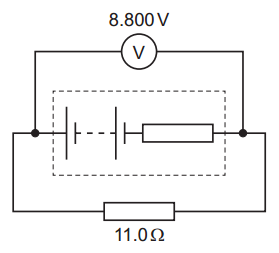 What is the internal resistance of the battery?
What is the internal resistance of the battery?
Medium
Mark as Complete
Mark Scheme
Question 7
The diagrams show two different circuits. The cells in each circuit have the same electromotive force (e.m.f.) and negligible internal
The cells in each circuit have the same electromotive force (e.m.f.) and negligible internal
resistance. The three resistors each have the same resistance R.
In the circuit on the left, the power dissipated in the resistor is P.
What is the total power dissipated in the circuit on the right?
A. `P/4`
B. `P/2`
C. `P`
D. `2P`
Medium
Mark as Complete
Mark Scheme
Question 8
Three identical lamps L1, L2 and L3 are connected to a battery with negligible internal resistance, as shown.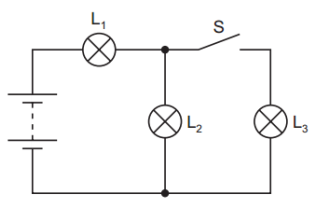 What happens to the brightness of lamps L1 and L2 when the switch S is closed?
What happens to the brightness of lamps L1 and L2 when the switch S is closed?
| Lamp L1 | Lamp L2 | |
|---|---|---|
| A | brighter | brighter |
| B | brighter | dimmer |
| C | dimmer | brighter |
| D | dimmer | dimmer |
Medium
Mark as Complete
Mark Scheme
Question 9
A cable of length `L` consisting of two wires is used to connect a 12.0 V power supply of negligible internal resistance to a lamp, as shown.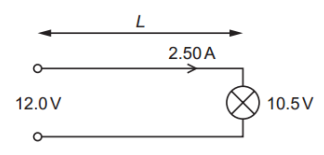
The potential difference across the lamp is 10.5 V. The current in the wire is 2.50 A.
Each wire is made of metal of resistivity 1.70 × 10−8 Ω.m and has a cross-sectional area of 6.00 × 10−7 m2.
What is the length `L` of the cable?
Hard
Mark as Complete
Mark Scheme
Question 10
A circuit consists of a battery, a voltmeter and five fixed resistors, as shown.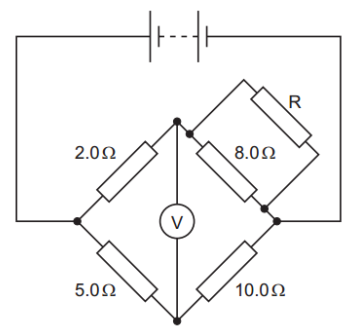
The voltmeter reading is zero.
What is the resistance of resistor `R`?
Hard
Mark as Complete
Mark Scheme
Question 1
Three resistors, each of resistance `R`, are connected in a network, as shown. The total resistance between points X and Y is 8.0 Ω. What is the value of `R`?
The total resistance between points X and Y is 8.0 Ω. What is the value of `R`?
Bottom branch resistance: `R_(series) = R + R = 2R`
The top branch has resistance `R`, and the bottom branch has resistance `2R`. These two are in parallel, so the total resistance `R_(XY)`:
`1/R_(XY) = 1/R + 1/(2R)`
`R_(XY) = 2R/3`
`2R/3 = 8 => 2R = 24 => R = 12 " " Omega`
Question 2
Some resistors and a battery of electromotive force (e.m.f.) E and negligible internal resistance are connected in series, as shown. Which statement is correct?
Which statement is correct?
A. The e.m.f. across each resistor equals the potential difference across the battery.
B. The potential difference across each resistor equals the e.m.f. E of the battery.
C. The sum of the e.m.f.s across the resistors equals the potential difference across the battery.
D. The sum of the potential differences across the resistors equals the e.m.f. E of the battery.
Answer: D
A. Incorrect:
Resistors do not produce emf - only sources like batteries do.
Resistors consume potential difference; they don’t have their own emf.
B. Incorrect: In a series circuit, the total voltage is divided among the resistors.
C. Incorrect: Only sources like batteries contribute e.m.f.
D. Correct: All the energy supplied by the battery (e.m.f) is used up in the resistors. Since there is negligible internal resistance, the entire emf appears across the resistors, and their combined potential differences must equal .
Question 3
In the circuit shown, a fixed resistor X is connected in series with a battery and a variable resistor.
The power dissipated in resistor X is 7.2 W when a current of 3.0 A passes through it.
The variable resistor is adjusted so that the power dissipated in X increases by 50%.
What is the new current in the circuit?
`P = I^2 xx R`
`R = 7.2 / 9 = 0.8" "Omega`
Power increases by 50%, so: `P_new = 1.5 * 7.2 = "10.8 W"`
`P_("new") = I_("new")^2 xx R => 10.8 = I_("new")^2 xx 0.8`
`=> I_("new")^2 = 10.8 / 0.8 = 13.5 => I_("new") = sqrt(13.5) ≈ "3.7 A"`
Question 4
A circuit contains a cell of electromotive force and internal resistance rr connected to a resistor of resistance . The current in the circuit is I. Which equation is correct?
Which equation is correct?
A. E − Ir.
B. E = Ir − IR.
C. E + Ir = IR.
D. E = IR.
Answer: A
A. Correct: This equation correctly accounts for both internal and external resistances in the circuit.
B. Incorrect: This would suggest emf equals a net negative voltage, which is unphysical here.
C. Incorrect: Adding the internal voltage drop to the emf suggests more voltage is delivered than the battery can provide.
D. Incorrect: This equation only applies when internal resistance r = 0, which is not the case here.
Question 5
A battery with a constant internal resistance is connected to a resistor of resistance 250 Ω, as shown. The current in the resistor is 40 mA for a time of 60 s. During this time, 6.0 J of energy is dissipated by the internal resistance.
The current in the resistor is 40 mA for a time of 60 s. During this time, 6.0 J of energy is dissipated by the internal resistance.
What is the energy supplied to the external resistor during the 60 s and the electromotive force (e.m.f.) of the battery?
| Energy/J | e.m.f./V | |
|---|---|---|
| A | 30 | 2.5 |
| B | 30 | 7.5 |
| C | 24 | 10.0 |
| D | 24 | 12.5 |
Answer: D
`E = I^2 xx R xx t`
`E = (0.04)^2 xx 250 xx 60 = 0.0016 xx 250 xx 60 = "24 J"`
Energy supplied to the external resistor is 24 J.
Energy supplied by battery: `E_("total") = 24 + 6 = "30 J"`
E.m.f. of the battery: `V = E / (I xx t)`
`V = 30 / (0.04 xx 60) = 30 / 2.4 = "12.5 V"`
Question 6
A voltmeter reads 9.000 V when it is connected across the terminals of a battery. When a resistor of resistance 11.0 Ω is connected in parallel with the battery, the voltmeter reading changes to 8.800 V.
When a resistor of resistance 11.0 Ω is connected in parallel with the battery, the voltmeter reading changes to 8.800 V. What is the internal resistance of the battery?
What is the internal resistance of the battery?
The terminal voltage of a battery under load is `V=E−Ir`
`V = E - (V / R) xx r`
`r = R xx (E - V) / V`
`r = 11 xx (9.000 - 8.800) / 8.800 = 11 xx 0.200 / 8.800 = 2.2 / 8.8 = 0.250 " " Omega`
Question 7
The diagrams show two different circuits. The cells in each circuit have the same electromotive force (e.m.f.) and negligible internal
The cells in each circuit have the same electromotive force (e.m.f.) and negligible internal
resistance. The three resistors each have the same resistance R.
In the circuit on the left, the power dissipated in the resistor is P.
What is the total power dissipated in the circuit on the right?
A. `P/4`
B. `P/2`
C. `P`
D. `2P`
Answer: B
Left circuit (1 resistor): `P_("left") = E^2 / R`
Right circuit (2 resistors in series): `R_("total") = R + R = 2R`
Power dissipated: `P_("right") = E^2/(2R) `
Compare with the left circuit power: `P_("left") = E^2 / R`
`P_("right") = E^2 / (2R) = (1/2) xx (E^2 / R) = P / 2`
Question 8
Three identical lamps L1, L2 and L3 are connected to a battery with negligible internal resistance, as shown. What happens to the brightness of lamps L1 and L2 when the switch S is closed?
What happens to the brightness of lamps L1 and L2 when the switch S is closed?
| Lamp L1 | Lamp L2 | |
|---|---|---|
| A | brighter | brighter |
| B | brighter | dimmer |
| C | dimmer | brighter |
| D | dimmer | dimmer |
Answer: B
When the switch is closed:
Lamp L3 is now connected in parallel with lamp L2.
Lamps L2 and L3 are in parallel, and that parallel combination is in series with lamp L1.
Effect on lamp L1:
Before: L1 was in series with L2 only.
After: L1 is in series with the parallel combination of L2 and L3.
Total resistance decreases (because parallel reduces resistance).
So current in the circuit increases.
L1 gets more current → brighter.
Effect on lamp L2:
Now it shares voltage with L3 (parallel).
In parallel, each lamp gets only part of the total current, so L2 receives less current than before (when it was in series alone with L1).
So L2 becomes dimmer.
Question 9
A cable of length `L` consisting of two wires is used to connect a 12.0 V power supply of negligible internal resistance to a lamp, as shown.
The potential difference across the lamp is 10.5 V. The current in the wire is 2.50 A.
Each wire is made of metal of resistivity 1.70 × 10−8 Ω.m and has a cross-sectional area of 6.00 × 10−7 m2.
What is the length `L` of the cable?
`V_("cable")= V_("battery") −V_("lamp") = 12.0 - 10.5 = "1.5 V"`
Since there are two wires, the total resistance: `R_("total") = 2 xx rho xx (L / A)`
`V _("cable") =IxxR _("total") =Ixx2xxρxx Axx L `
`L = (V_("cable") xx A) / (2 xx rho xxI)`
`L = (1.5 xx 6.00xx10^-7) / (2 xx 1.70xx10^-8 xx 2.50) = (9.00xx10^-7) / (8.50xx10^-8) ≈ "10.6 m"`
Question 10
A circuit consists of a battery, a voltmeter and five fixed resistors, as shown.
The voltmeter reading is zero.
What is the resistance of resistor `R`?
Recreate the circuit diagram: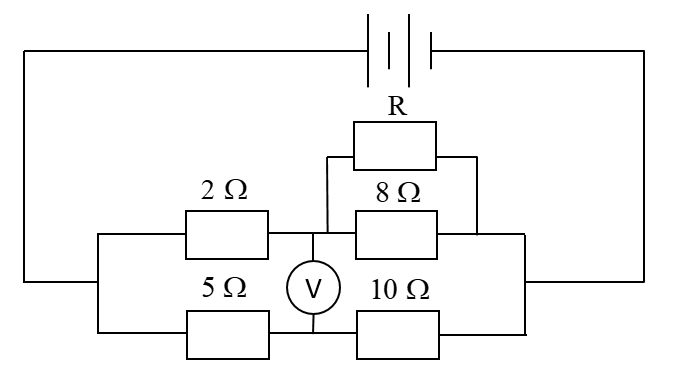
`V_(5Omega)=5/(10+5)xxE`
`V_(2Omega)=2/(2+R_("right"))xxE`
Since, the voltmeter reading is zero `5/(10+5)xxE=2/(2+R_("right"))xxE`
`R_("right")=4 " " Omega`
`1/(R_(right"))= 1/8+1/R`
`1/4= 1/8+1/R`
`R=8" "Omega`
Question 1
Three resistors, each of resistance `R`, are connected in a network, as shown. The total resistance between points X and Y is 8.0 Ω. What is the value of `R`?
The total resistance between points X and Y is 8.0 Ω. What is the value of `R`?
Question 2
Some resistors and a battery of electromotive force (e.m.f.) E and negligible internal resistance are connected in series, as shown. Which statement is correct?
Which statement is correct?
A. The e.m.f. across each resistor equals the potential difference across the battery.
B. The potential difference across each resistor equals the e.m.f. E of the battery.
C. The sum of the e.m.f.s across the resistors equals the potential difference across the battery.
D. The sum of the potential differences across the resistors equals the e.m.f. E of the battery.
Question 3
In the circuit shown, a fixed resistor X is connected in series with a battery and a variable resistor.
The power dissipated in resistor X is 7.2 W when a current of 3.0 A passes through it.
The variable resistor is adjusted so that the power dissipated in X increases by 50%.
What is the new current in the circuit?
Question 4
A circuit contains a cell of electromotive force and internal resistance rr connected to a resistor of resistance . The current in the circuit is I. Which equation is correct?
Which equation is correct?
A. E − Ir.
B. E = Ir − IR.
C. E + Ir = IR.
D. E = IR.
Question 5
A battery with a constant internal resistance is connected to a resistor of resistance 250 Ω, as shown. The current in the resistor is 40 mA for a time of 60 s. During this time, 6.0 J of energy is dissipated by the internal resistance.
The current in the resistor is 40 mA for a time of 60 s. During this time, 6.0 J of energy is dissipated by the internal resistance.
What is the energy supplied to the external resistor during the 60 s and the electromotive force (e.m.f.) of the battery?
| Energy/J | e.m.f./V | |
|---|---|---|
| A | 30 | 2.5 |
| B | 30 | 7.5 |
| C | 24 | 10.0 |
| D | 24 | 12.5 |
Question 6
A voltmeter reads 9.000 V when it is connected across the terminals of a battery. When a resistor of resistance 11.0 Ω is connected in parallel with the battery, the voltmeter reading changes to 8.800 V.
When a resistor of resistance 11.0 Ω is connected in parallel with the battery, the voltmeter reading changes to 8.800 V. What is the internal resistance of the battery?
What is the internal resistance of the battery?
Question 7
The diagrams show two different circuits. The cells in each circuit have the same electromotive force (e.m.f.) and negligible internal
The cells in each circuit have the same electromotive force (e.m.f.) and negligible internal
resistance. The three resistors each have the same resistance R.
In the circuit on the left, the power dissipated in the resistor is P.
What is the total power dissipated in the circuit on the right?
A. `P/4`
B. `P/2`
C. `P`
D. `2P`
Question 8
Three identical lamps L1, L2 and L3 are connected to a battery with negligible internal resistance, as shown. What happens to the brightness of lamps L1 and L2 when the switch S is closed?
What happens to the brightness of lamps L1 and L2 when the switch S is closed?
| Lamp L1 | Lamp L2 | |
|---|---|---|
| A | brighter | brighter |
| B | brighter | dimmer |
| C | dimmer | brighter |
| D | dimmer | dimmer |
Question 9
A cable of length `L` consisting of two wires is used to connect a 12.0 V power supply of negligible internal resistance to a lamp, as shown.
The potential difference across the lamp is 10.5 V. The current in the wire is 2.50 A.
Each wire is made of metal of resistivity 1.70 × 10−8 Ω.m and has a cross-sectional area of 6.00 × 10−7 m2.
What is the length `L` of the cable?
Question 10
A circuit consists of a battery, a voltmeter and five fixed resistors, as shown.
The voltmeter reading is zero.
What is the resistance of resistor `R`?